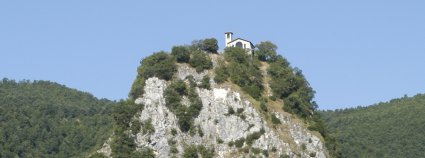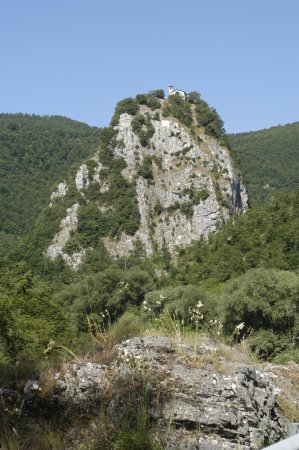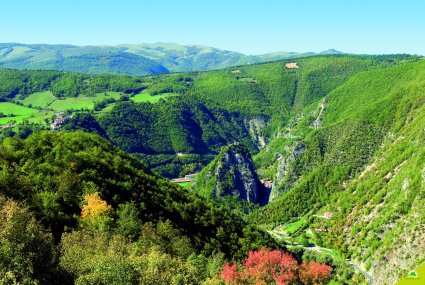Our network:
Wednesday 16 April 2025
Nature Walks Around Cascia:To Cascia via the Scoglio di Santa Rita, the vast rocky pyramid that dominates the village of Roccaporena
 |
A trip to Roccaporena for the annual Festa delle Rose e delle Rite on June 22nd can be an ideal opportunity to discover the little known but spectacular natural landscape of this area. Along the Corno and Tissino basins an itinerary runs from Roccaporena towards the Medieval hamlet of Monteleone di Spoleto and continues for Poggiodomo and Cerreto di Spoleto.
Along with its strategic position between the Valle del Corno and the Valle del Tissino, a number of important archaeological digs have confirmed that Roccaporena has been inhabited for thousands of years. Today the village is known primarily as a place of pilgrimage, attracting hosts of faithful who come here to venerate the so-called “Scoglio di Santa Rita”, a large oblong-shaped rock believed to have the marks of St Rita’s knees and elbows.
 |
A number of other interesting plant species grow along the course of the river Corno, such as white willow, Alnus Glutinosa, elm and walnut, with the small fields in the valley below punctuated by the silhouettes of poplar trees. The woodland of this area is composed primarily of ilex and carpinus, which grow at irregular density according to the steepness and exposition of the slopes that house them. The slopes that run from Roccaporena towards Cascia face northwards and, even at fairly low altitude, contain copses of beech and laburnum. This area is also rich in interesting fauna, particularly that which is endemic to mountain river habitats such as river shrimps, which survives here and in few other places in the Valnerina. These same waters also support salmon trout, the Apennine frog and the White Throated Dipper. A few examples of Spectacled Salamander were spotted in the 1990s and should still be ‘in residence’. The chalk cliffsides of these
mountains are the ideal nesting place for an abundant variety of bird life such as the common kestrel, the mountain swallow, sparrows, Black Redstarts, magpies and even a pair of Lanner falcons – a very rare bird of prey that is present in only ten sites in the whole of Umbria.
 |
Info:
Servizio Turistico Associato della Valnerina
Sede operativa: Via G. da Chiavano, 2 – 06043 Cascia (PG) Tel. 0743.71401 – Fax 0743.76630
e-mail info@iat.cascia.pg.it
| Have a comment or question? Send a message to our editors at: contactus@perugiaonline.com |
| Up |

General information
• General travel tips • Weather information
• Tourist guides and visit guided in Umbria
• Local opening times
• Useful - emergency numbers
• Perugia for living
• Hospital Perugia
• Hospital Foligno
• Real Estates and Home Builders
• Homes for sale, property, apartments selling
Transport in town
• Traffic restrictions • Parking
• Buses & Taxis
• Town map
• How to reach Perugia by car
• How to reach Perugia by train
• How to reach Perugia by Air
Transport out of town
• Airport • Trains
• Rent a car
• Local and national buses

Where to Stay
OFFERS & LAST MINUTE
Where to eat and drink
• Restaurants and Trattorie • Pizzerie
• Pubs

Art and monuments
• Rocca Paolina • Ipogeo dei Volumni
• Etruscan town walls
• Palazzo dei Priori
• Porta Sant' Angelo
• Acqueduct
• Maesta delle Volte
• Collegio della Mercanzia
• Collegio del Cambio
• Fontana Maggiore
Art and religion
• Cathedral of San Lorenzo • Church of San Filippo Neri
• Oratory of San Bernardino
• Church of Sant' Ercolano
• Church of San Domenico
• Church of San Pietro

Museums and galleries
• Historic Museum Perugina • Galleria Nazionale dell'Umbria
• Museo Archeologico
• Palazzo della Penna
• Accademia delle Belle Arti
• Museo di Storia Naturale
• Museo Capitolare San Lorenzo
• Cappella di San Severo
Art and tourist attractions
• Palazzo Capitano del Popolo • Botanical garden
Booking.com
• MUSIC • EXHIBITIONS • COURSES • COMPETITIONS & PRIZES • FOLKLORE • EVENTS • DANCE & BALLET • MEETING & CONFERENCES • CONGRESS • KIDS • Typical Products FAIRS • THEATRE • SPORT EVENTS • LEISURE • LIFESTYLE • WHERE TO DINNER • NIGHTLIFE • CURIOSITY • VIDEO • BOOKS
• Italian language courses
• The Amusement Park : La Citta della Domenica
• Golfing holidays
• Nature Walks Around Cascia:To Cascia via the Scoglio di Santa Rita, the vast rocky pyramid that dominates the village of Roccaporena
• Cooking courses
• Shopping in Perugia
• Perugia Hotel Tevere
• Assisi Villa Giulia
• The islands - boat tours
• Eating well by Lake Trasimene
• Bathing - Lake Trasimene

• Wellness in Umbria - Perugia area
• Weddings in Umbria
• Honeymooning in Umbria
• Charme & Relax in Umbria
• Home in Umbria
• Cooking schools
• University for Foreigners Perugia
• Design, Fashion, Visual arts and Communication Schools
• Perugia for Studying
• University
• Italian Army Foreign Language School
• Arts, Music, etc.

• Handicraft
• Mushrooms
• Truffles
• Extra Virgin Olive Oil
• Wine
• Oleum Evo online selling
• Sapori Tipici Italiani buy now
• From the forest

Perugia News
Sorry, non news - i soggetti interessati a far conoscere le iniziative che avranno luogo nell'ambito del territorio comunale sono invitati a darne comunicazione con congruo anticipo utilizzando l'email redazione@umbriaonline.com
Regional News by Category
• MUSIC • EXHIBITIONS • COURSES • COMPETITIONS & PRIZES • FOLKLORE • EVENTS • DANCE & BALLET • MEETING & CONFERENCES • CONGRESS • KIDS • Typical Products FAIRS • THEATRE • SPORT EVENTS • LEISURE • LIFESTYLE • WHERE TO DINNER • NIGHTLIFE • CURIOSITY • VIDEO • BOOKS
What to see & do
• Itineraries & Museums in Umbria • Italian language courses
• The Amusement Park : La Citta della Domenica
• Golfing holidays
• Nature Walks Around Cascia:To Cascia via the Scoglio di Santa Rita, the vast rocky pyramid that dominates the village of Roccaporena
• Cooking courses
• Shopping in Perugia
• Perugia Hotel Tevere
• Assisi Villa Giulia
Lake Trasimeno
• General Information • The islands - boat tours
• Eating well by Lake Trasimene
• Bathing - Lake Trasimene

SPECIALS in Umbria - Italy
• Gift Ideas for traveling • Wellness in Umbria - Perugia area
• Weddings in Umbria
• Honeymooning in Umbria
• Charme & Relax in Umbria
• Home in Umbria
Education
• Language schools for Foreigners • Cooking schools
• University for Foreigners Perugia
• Design, Fashion, Visual arts and Communication Schools
• Perugia for Studying
• University
• Italian Army Foreign Language School
• Arts, Music, etc.

Typical products
• Norcia Ham IGP • Handicraft
• Mushrooms
• Truffles
• Extra Virgin Olive Oil
• Wine
Flavours to taste
• Salumi Tipici Italiani online selling • Oleum Evo online selling
• Sapori Tipici Italiani buy now
• From the forest









